Jiddah: A remarkable discovery in the Nefud Desert of northern Saudi Arabia has unveiled human footprints dating back 115,000 years, challenging previous ideas about early human activity in the Arabian Peninsula.
This extraordinary find was made in 2017 at a site locals call “the trace,” where natural erosion stripped away overlying sediment to reveal what was once a muddy lakebed bustling with prehistoric life.
Such lakebeds were likely high-traffic areas for ancient humans, serving as watering holes and fertile grounds for hunting and gathering. Footprints left in the soft mud by these early inhabitants were preserved by natural processes, only to be exposed after thousands of years. The remarkable preservation is partly due to the unique properties of mud, which can capture and protect fine details of footprints before they are buried and fossilized.
Interestingly, modern experiments show that footprints in mud can disappear or become unrecognizable within just a few days due to drying and erosion. This makes the survival of these 115,000-year-old prints even more extraordinary, highlighting the rare and delicate conditions that allowed this snapshot of prehistoric life to be preserved for scientists to study today.
This discovery not only provides direct evidence of early human presence in an area where it was once unexpected but also offers insight into how ancient environments played a role in preserving such traces. The Nefud Desert site adds a valuable chapter to the story of human migration and survival during the Late Pleistocene era.
Fun Fact: Some of the best-preserved ancient footprints come from mud environments because mud can capture intricate details, but these prints usually vanish within days unless they are quickly covered by sediment.
Follow PreHistoric World for more fascinating archaeological discoveries and insights into the lives of our earliest ancestors. (Agencies)

